|
The McCloud forests support a number of tree species, but six of them stand out as being the most important commercial species. Logging in the first several decades focused principally on four of
these species, and changes in forest composition caused by that early logging and long term fire suppression have substantially increased the importance of the other two. Much of the information and drawings
on this page are from Important Forest Trees of the United States, U.S> Forest Service/United States Department of Agriculture Handbook No. 519, published in 1979.
|
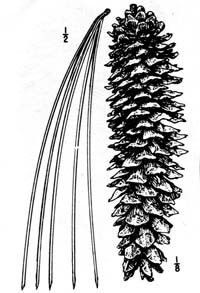 |
Sugar pine (Pinus lambertiana) was commercially the most important tree species in the McCloud woods in the early years. Sugar pines are the world's
largest pine species and are found only in the Sierra Nevada and southern Cascade mountain ranges of Oregon, California, and Baja California. The trees can grow to heights of 150-200 or more feet tall and the
trunks up to seven feet in diameter, and the very large cones typically measure out at 10-18 inches long. The long straight trunks without lower limbs produced high quality lumber used for building construction,
boxes and crates, millwork, and foundary patterns. |
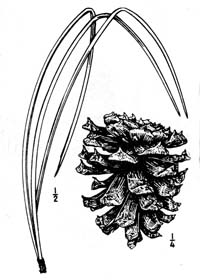 |
Ponderosa pine (Pinus ponderosa) is the most common commercial tree species in the McCloud country. Ponderosa pines are the most widely distribtued
pine species in North America, with a range from southern Canada to northern Mexico and from the California coast east to Nebraska and South Dakota. The species grows to an average height of 125-180 feet and up
to six feet in diameter. In pre-European contact conditions frequent low intensity fires checked encroachment of brush and competing tree species, resulting in open park-like stands of mature trees. Fire suppression
typically allows for other tree species to invade and eventually replace Ponderosas. The lumber from this species is among the most versatlie in existence, with principal uses including building construction, boxes,
furniture, windows and doors, panels, patterns, toys, caskets, post, poles, Christmas trees, and decorations. |
 |
Incense cedar (Calocedrus decurrens) is a slow growing tree that is naturally found as a minority species in mixed stands with pines and other trees
in the McCloud woods. It is one of the species that increases in abundance in formerly pine dominated stands from which fires have been excluded. McCloud River Lumber Company rarely if ever logged this species,
but several other companies, most noteably the Elkins operations, logged the cedar trees on company lands after McCloud had harvested all of the pine. The trees typically grow to a height of 70-110 feet and up to five
feet in diameter. Susceptibility to a heartwood fungus tends to limit the commercial uses of this tree. Most of the cedar logged in the McCloud region went to pencil stock. Other uses includes exterior siding, sheathing,
subflooring, interior paneling, woodwork, toys, fence posts, rails, poles, and roofing shingles.
|
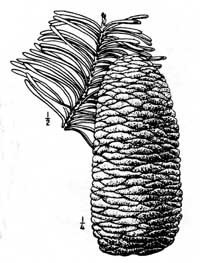 |
Shasta red fir (Abies x shastensis) is a recognized hybrid of California red fir (Abies magnifica) which resides in the Sierras to the south
and Noble fir (Abies procera)which lies in the Cascades to the north. This tree is found in pockets the Cascade, Klamath, and Trinity mountain ranges of northern California, grows to a height of 125-200 feet
tall, and has trunks up to five feet in diameter. Principal commercial uses includes lumber for construction of all types, boxes and crates, plywood, and pulpwood. The McCloud company tended to only log this species
to cut construction timbers and railroad ties for its own uses.
|
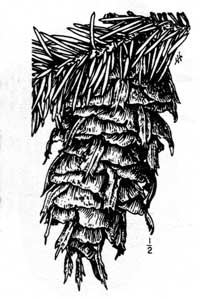 |
Douglas fir (Pseudotsuga menziesii) is the most common and widely distrubuted commercial tree species in the United States. The species tends to be a
"pioneer" tree species, one of the first to colonize recently catastrophically burned areas, but the fire regime in most of the pine dominated areas of the McCloud region restricted this species to higher elevations.
However, it was typically one of the first species growing in recently logged areas, and as a result it is far more common and commercially important in northeastern California today than it ever was during the rail
logging era. The trees grown to 100-250 or more feet high and up to six feet in diameter. Lumber from this species has many uses, including construction of all types, timbers, pilings, plywood, veneer, and millwork.
|
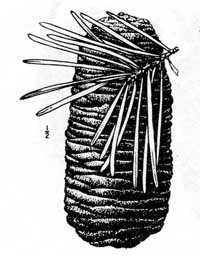 |
White fir (Abies concolor) has become one of the most common species in the McCloud woods in modern times. This tree can grow up to 200 feet tall and
five feet in diameter. The tree was long considered a "trash" species from which no commercially valuable lumber could be extracted due to knots and general softness of its wood, and much like Douglas fir was
suppressed by the frequent low intensity fires of pre-European contact. The tree however thrived in sites post-logging, and it combined with Incense cedar are becoming the dominent species throughout much of
the one time pine forests in the region that have been "protected" from fire. The tree tends to grow in dense thickets in areas that don't burn. After being shunned by the industry for decades, the species is
gaining increasing importance as other species decline in abundance and the market seems willing to accept lower quality lumber.
|
|
|





